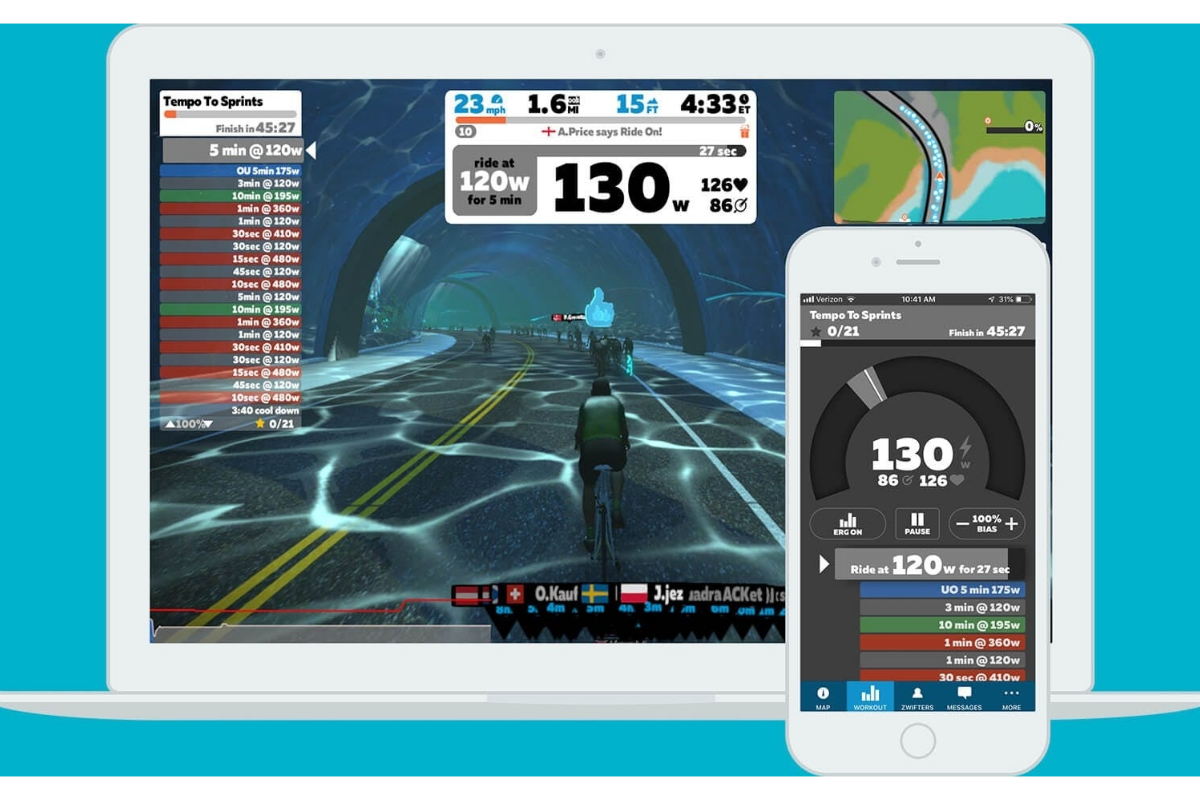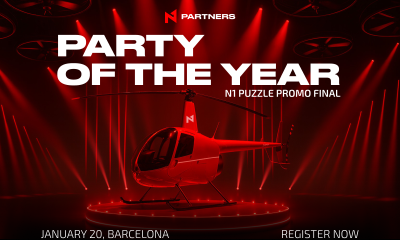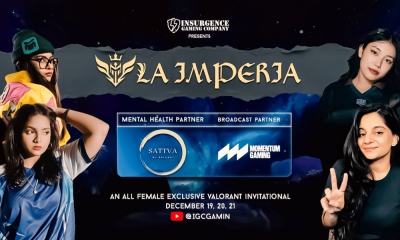Industry News
Virtual bike races as hard as Tour de France, says expert

- Virtual cycle races take place of cancelled road races
- Big names like Chris Froome have been taking part
- Cycling data expert says virtual races are proving to be just as hard as the real thing
Virtual cycle racing is proving to be just as hard as road races such as the Tour de France, according to professional riders and a leading sports data analyst.
Races on virtual platforms such as Zwift and ROUVY have filled the void left by the cancellation of professional road races over the past few weeks, with big-name riders like Chris Froome and Olympic champion Greg Van Avermaet taking part in events such as the Digital Swiss 5, the Zwift Tour for All and the Team INEOS eRace on Zwift.
Together with a panel of cycling experts from bonusfinder.com, professional cycling coach and data scientist Philipp Diegner – who regularly analyses UCI WorldTour races – has assessed the publicly available performance data from more than 200 efforts made by pro riders in recent virtual races.
Although virtual races are up to six times shorter than road races, Diegner said they have proved to be just as difficult as road races and have caught some professionals off guard. ”The racing is short and particularly intense,” he explained. “It is 45-90 minutes of racing instead of 3-6 hours. The consequence for the riders is that there is no opportunity to save energy like they have in road races, so they have to make prolonged, all-out efforts that push them to their physical limit.
“Professionals are not necessarily used to this and it can be a shock to the system. Virtual racing is as hard as road racing; it is just that endurance is a more decisive factor in road racing, whereas virtual racing is one hour of pure, intense suffering.”
Pro rider Chris Hamilton, who rides for Team Sunweb, agreed with Diegner when he described one virtual race as “the hardest thing I have ever done”.
Diegner selected the following 10 performances as the most impressive he has seen in the professional virtual races to date.
| Rider | Team | Race | Time | Speed (avg km/h) | Power (avg watts) | W/kg (avg) | Ride Info Source |
| Chris Hamilton | Team Sunweb | Digital Swiss 5 Race 5 | 01:00:13 | 37.7 | 393 | 6.05 | Strava |
| Filippo Ganna | Team INEOS | Digital Swiss 5 Race 2 | 00:55:17 | 48.7 | 463 | 5.51 | Strava |
| James Piccoli | Israel Start-Up Nation | Zwift Tour for All Stage 3 | 01:41:56 | 42.7 | 335 | 5.2 | Zwift Companion |
| Louis Meintjes | NTT Pro Cycling | Zwift Tour for All Stage 5 | 01:23:40 | 33.3 | 323 | 5.7 | Zwift Companion |
| Stefan De Bod | NTT Pro Cycling | Zwift Tour for All Stage 5 | 01:23:49 | 33.3 | 357 | 5.4 | Zwift Companion |
| Nicolas Roche | Team Sunweb | Digital Swiss 5 Race 3 | 01:12:11 | 27.9 | 391 | 5.51 | Strava |
| Pello Bilbao | Bahrain – McLaren | Zwift Tour for All Stage 3 | 01:42:39 | 42.4 | 330 | 5.5 | Zwift Companion |
| Rohan Dennis | Team INEOS | Team INEOS eRace on Zwift | 00:58:01 | 29.2 | 373 | 5.18 | Zwift Companion |
| Tobias Ludvigsson | Groupama – FDJ | Digital Swiss 5 Race 4 | 00:48:00 | 46 | 428 | 5.63 | Strava |
| Nicolas Roche | Team Sunweb | Digital Swiss 5 Race 3 | 00:54:17 | 29.4 | 397 | 5.59 | Strava
|
Watts per kilogram is widely recognised as the most accurate barometer of effort in pro cycling. It takes the average power a rider produces over a set period of time and divides it by their weight in kilograms. The hardest road races require the winner to produce about 4/wkg over five hours. In virtual races, the winners have been nudging 6w/kg for between one hour and 1hr 45min.
Diegner said: “Chris Hamilton only finished fourth in race five of the Digital Swiss 5 but riding for one hour at 6.05w/kg is world class. He rode the last 12 minutes at 6.58w/kg, which would win him most WorldTour mountain stages.
“James Piccoli’s win on stage three of the Zwift Tour for All was a similarly amazing effort. He rode for one and a half hours at over 5w/kg and then kicked again and rode the last six minutes 25 seconds at 6.46w/kg. That’s unimaginable for amateur riders on Zwift.”
One lesson that emerged from the analysis was that the riders who are most successful on the road, such as Froome and 2019 Tour de France winner Egan Bernal, were not necessarily as effective in virtual races.
Diegner believes this was because successful road riders did not adjust to the nuances of virtual racing as well as others, but he expects them to start replicating their road success in virtual races with time and experience.
“Take Egan Bernal in the Team INEOS eRace on Zwift,” Diegner added. “He wasn’t competitive. That may be because he did not go all-out and was treating it as a training effort. But ultimately, once a rider with his capability gets used to the intensity, he will start winning like he does on the road.
“It is similar with sprints. Someone like [former three-time world champion] Peter Sagan might not get virtual racing right to begin with, but when he learns when and how to expend his power, he will start winning with the same regularity as on the road. Knowing when to start the sprint and how to reach max power in online races is a skill that has to be developed.”
Powered by WPeMatico
5W
5WPR Expands Gambling and Gaming PR and Digital Marketing Services Ahead of 2026

5W, one of the largest independently owned PR firms in the US, announced the expansion of its gambling PR and digital marketing services, helping iGaming operators, sports betting platforms, casinos, esports brands, and gaming studios prepare for the year ahead. The enhanced offering is designed to elevate brand visibility, build trust with players and partners, and drive measurable growth as the industry enters 2026.
5W provides integrated PR, digital marketing, and online reputation management solutions, including media relations, influencer partnerships, content creation, SEO, social campaigns, email marketing, event promotion, and crisis communications. For digital-first strategies, digital PR ensures brands reach the right audiences while strengthening credibility across search and social platforms.
“Our expanded gambling and gaming PR and digital marketing services are designed to help brands enter 2026 with momentum. By integrating PR, digital marketing, and reputation management, we help clients stand out, connect with audiences, and build trust that drives growth for the year ahead,” said Ronn Torossian, Founder & Chairman of 5W.
This expansion underscores 5W’s commitment to delivering results-driven communications and digital marketing solutions for high-growth and established brands in gambling, gaming, and esports.
The post 5WPR Expands Gambling and Gaming PR and Digital Marketing Services Ahead of 2026 appeared first on Americas iGaming & Sports Betting News.
fintech
PayDo Launches Unified Payment Infrastructure Suite for Digital Businesses

Reading Time: 2 minutes
PayDo, a leading global payment ecosystem founded by Serhii Zakharov – who at just 25 became one of the youngest CEOs approved by the FCA to run an Electronic Money Institution in the UK, announced a series of strategic infrastructure launches designed to dismantle the costly complexity of modern payment stacks.
The releases—Direct SEPA & SEPA Instant access, USD SWIFT Accounts, Dedicated C2B Open Banking Collections Accounts and Direct VISA and MasterCard Acquiring—are not standalone products, but integrated components of PayDo’s unified platform.
For the first time, online businesses can access this comprehensive suite under a single contract, one technical integration and with a dedicated account manager, eliminating the operational burden of managing multiple providers.
The launches directly address the primary pain points of payment fragmentation: high costs from intermediaries, slow settlement times, compliance overhead and loss of control. By securing direct memberships and building proprietary technology, PayDo now offers businesses enterprise-grade infrastructure with the agility of a FinTech.
The new services include:
• Direct SEPA & SEPA Instant: As a direct SEPA member, PayDo provides native European processing with no intermediary routing. This ensures faster, lower-cost euro transactions with immediate settlement capabilities via SEPA Instant.
• USD SWIFT Accounts: Online businesses can now receive dedicated USD account details via the SWIFT network, significantly reducing delays and fees associated with cross-border USD transactions, a critical need for a variety of cross-border operating online businesses.
• Dedicated C2B Open Banking Collections Accounts: A pioneering innovation, this service revolutionises how businesses receive payments. It enables instant, direct bank-to-business transfers from customers, offering an alternative to card networks with correct funds tracking and allocation, lower costs and real-time settlement. Functionality supports processing of +100,000 daily transactions.
• Launch of Direct Acquiring: PayDo is now a principal member acquirer for both Visa and Mastercard. This direct relationship removes a layer of intermediaries, reducing processing costs, improving authorisation rates and giving merchants greater control and transparency over their card payment flows.
These services are delivered within PayDo’s unified ecosystem, which also includes its signatory innovation – non-redirect E-Wallet checkout. This earlier innovation provided merchants with full friendly-fraud protection without any rolling reserve requirements. The new ecosystem approach allows companies in sectors like e-commerce, IT services, marketplaces, gaming and other Fintechs to streamline their entire financial operations, turning payment management from a resource drain into a competitive advantage.
Serhii Zakharov, CEO and Founder of PayDo, said: “For years, businesses have been forced to stitch together a patchwork of payment providers, each adding cost, complexity, and delay. We believe the future is not in more fragmentation, but in intelligent unification. These launches are not just new features; they are the foundational pillars of a coherent ecosystem. We are giving our clients direct control over the core rails of finance—from SEPA and SWIFT to card acquiring and Open Banking—all through one partnership. This is how we eliminate the hidden tax of fragmentation and empower businesses to scale globally with clarity and efficiency.”
PayDo’s ecosystem now processes over €5B annually for over 1000 businesses, leveraging its full regulatory compliance in the UK, Canada and the EU. The company’s direct infrastructure model is proving that the next wave of Fintech growth will be driven by consolidation and seamless integration, not further division.
The post PayDo Launches Unified Payment Infrastructure Suite for Digital Businesses appeared first on European Gaming Industry News.
Free Bet
Meridianbet Reports Renewed Engagement in Custom Prediction Markets in H2 2025

Reading Time: 2 minutes
While prediction markets have recently attracted increased public attention across politics, finance and culture, Meridianbet, part of the Golden Matrix Group has supported user-generated real-world prediction markets for more than a decade through its proprietary product branded as Free Bet.
For the second half of 2025, customer participation on the Free Bet platform has recorded an 11.5% increase in ticket volumes, reflecting renewed engagement across prediction markets tied to major elections, entertainment outcomes, weather forecasting and novelty-event propositions. Free Bet continues to represent a relatively small and non-material portion of Meridianbet’s overall wagering activity.
Free Bet allows customers to propose wagers on measurable real-world outcomes across sports, politics, entertainment awards, weather forecasting, financial milestones and social statistics. Once a proposed market passes regulatory, settlement and risk review, Meridianbet acts as the professional market maker, prices the odds and takes the lay side of each wager within the Company’s licensed sportsbook framework. This single-market-maker structure enables the delivery of prediction-market-style wagering to mass-market users while ensuring regulatory compliance, operational stability and standardised settlement.
In practical terms, customers initiate Free Bet markets by submitting their own proposed prediction events through Meridianbet’s platforms or retail network. Each submission is reviewed to ensure that the proposed event is lawful, ethically appropriate, clearly measurable and capable of unambiguous settlement under applicable regulatory standards. Only after passing these checks is the event accepted and priced by Meridianbet’s trading operators, who establish odds and offer the market to the customer for wagering.
Top Prediction Markets on Meridianbet
Over the past five years, Meridianbet customers have created and wagered on thousands of custom prediction markets reflecting major real-world outcomes across political cycles, cultural awards, financial milestones, weather forecasting and social trends.
Based on internal ticket volume and platform engagement data, the following five prediction markets have ranked among the most actively played on Meridianbet during this period:
U.S. Presidential Election
Binary outcome markets and related propositions tied to the U.S. presidential election results.
Global Entertainment Awards
Custom markets associated with major award outcomes including Oscars Best Picture and BBC Sports Personality of the Year.
Weather Prediction Markets
Seasonal and location-specific forecasts, including snowfall occurrence and temperature benchmark outcomes during late winter and early spring periods.
Social Outcome Markets
Demographic and statistical propositions connected to public milestones, including birth-gender distributions during peak holiday periods and other large-scale social outcome measurements.
Regulatory & Availability Notice
The Free Bet product and related prediction market offerings are provided strictly in accordance with applicable national and local regulatory requirements and are available only in jurisdictions where such wagering formats are duly authorised by law.
Availability, market scope and wagering features may vary by location and regulatory regime. Certain jurisdictions may restrict or prohibit participation in custom prediction-based wagering products.
The post Meridianbet Reports Renewed Engagement in Custom Prediction Markets in H2 2025 appeared first on European Gaming Industry News.
-

 Latest News6 days ago
Latest News6 days agoVegangster Gives Operators Real-Time Jackpot Control and a New Revenue Stream with Sharedluck’s JackpotX
-

 Latest News6 days ago
Latest News6 days agoRegistration Open: N1 Puzzle Promo Show & Winner Announcement in Barcelona
-

 affiliate marketing5 days ago
affiliate marketing5 days agoSOFTSWISS 2025: 45% Game Portfolio Growth, LatAm Extensive Expansion and Flagship iGaming Trends Report
-

 Asia7 days ago
Asia7 days agoInsurgence Gaming Company Introduces La Imperia, a Community-First All-Female VALORANT Tournament
-

 Christos Zoulianitis Chief Commercial Officer at ENJOY6 days ago
Christos Zoulianitis Chief Commercial Officer at ENJOY6 days agoENJOY Gaming turns up the heat with Hotfire Diamonds 2: Hold and Win 3x5x3
-

 Latest News6 days ago
Latest News6 days agoVegangster Gives Operators Real-Time Jackpot Control and a New Revenue Stream with Sharedluck’s JackpotX
-

 Latest News6 days ago
Latest News6 days agoTraffy Expands Its Global Impact in Mobile Performance Marketing
-

 B2B5 days ago
B2B5 days agoXpoint secures new growth funding to supercharge geolocation innovation for real money gaming



















